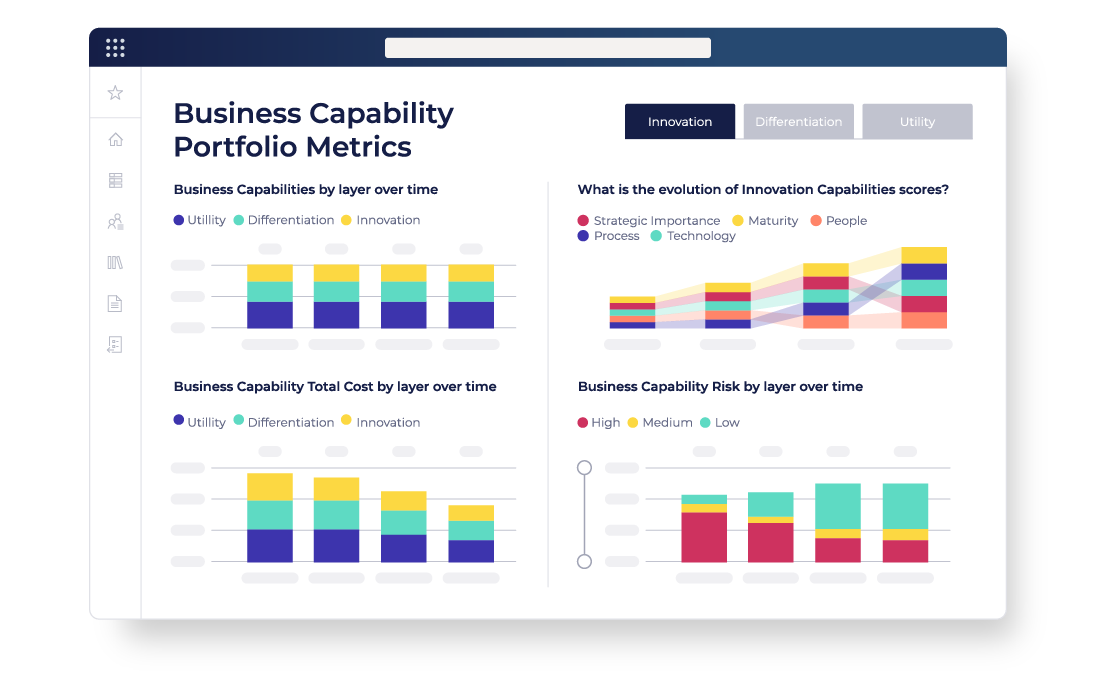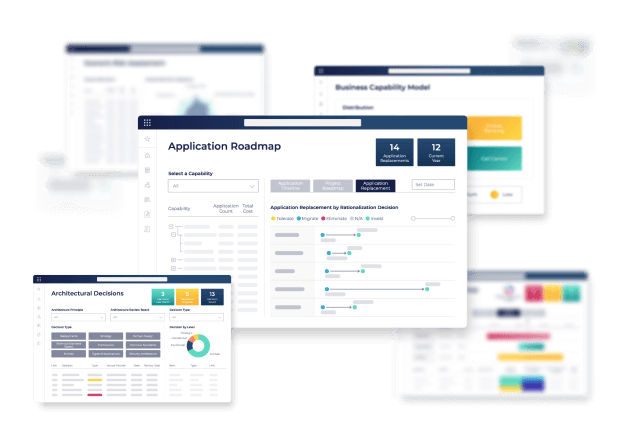Business Capability Mapping
Introduction
In today's fast-paced and competitive business landscape, organizations need to continuously adapt and innovate to succeed. To achieve this, they require a clear understanding of their core strengths and capabilities. Business capability mapping is a powerful tool that helps organizations identify, assess, and leverage their capabilities to achieve their strategic objectives.
What is Business Capability Mapping?
Business capability mapping is a process that involves visually representing and documenting an organization's capabilities and how they interrelate. It provides a holistic view of what an organization can do to execute its business strategy. Unlike traditional process mapping, which focuses on how tasks are performed, business capability mapping focuses on what the organization is capable of achieving. A business capability is a particular ability or expertise required to perform a core business function. It encompasses the people, processes, technologies, and resources necessary to deliver specific outcomes. By mapping these capabilities, organizations can gain a clear understanding of their internal strengths and weaknesses, identify areas for improvement, and align their resources to achieve strategic goals.

The Benefits of Business Capability Mapping
Business capability mapping offers a range of benefits for organizations seeking to optimize their operations and drive innovation. These benefits include:
- Enhanced Strategic Alignment: By mapping their capabilities, organizations can align their resources and activities with their strategic goals. This alignment ensures that every capability contributes directly to the organization's overall objectives, eliminating redundancies and improving efficiency.
- Improved Decision-Making: Business capability mapping provides organizations with a comprehensive view of their capabilities, enabling better decision-making. It helps leaders understand the impact of their decisions on different business functions and identify potential risks and opportunities.
- Agility and Adaptability: In today's dynamic business environment, organizations need to be agile and adaptable. Business capability mapping allows organizations to quickly identify areas where new capabilities are needed to respond to market changes and customer demands. It provides a roadmap for building the necessary capabilities to stay competitive.
- Resource Optimization: By identifying their core capabilities, organizations can optimize their resource allocation. They can focus their investments on the capabilities that provide the most value and competitive advantage while divesting or outsourcing non-core capabilities.
- Improved Collaboration and Communication: Business capability mapping promotes cross-functional collaboration and improves communication within the organization. It provides a common language and understanding of capabilities, enabling teams to work together more effectively towards shared goals.
The Process of Business Capability Mapping
Business capability mapping involves several steps to develop a comprehensive and actionable capability map. These steps include:
- Defining Business Capabilities: The first step in business capability mapping is to define the key capabilities of the organization. This involves identifying the core business functions and determining the specific abilities and expertise required to perform those functions. It's important to define capabilities using a consistent naming convention and provide concise one-sentence definitions.
- Creating a Capability Hierarchy: Once the capabilities are defined, they need to be organized into a hierarchical structure. This capability hierarchy helps ensure that capabilities are non-overlapping and unique. It also allows for a better understanding of how capabilities relate to each other and supports effective decision-making.
- Assessing Capability Fulfillment: After creating the capability hierarchy, it's essential to assess the degree to which each capability is fulfilling its strategic objectives. This assessment involves evaluating factors such as available capacity, materials, expertise, and technology. It helps identify any gaps or areas for improvement in capability fulfilment.
- Identifying Capability Gaps: Based on the assessment, it's important to identify any capability gaps that exist. These gaps represent areas where the organization needs to build new capabilities or improve existing ones to achieve strategic objectives.
- Developing a Capability Roadmap: Once capability gaps have been identified, it's important to develop a capability roadmap that outlines the steps needed to close those gaps. This roadmap should include timelines, resource requirements, and cost estimates.
Examples of Business Capability Maps
There are different ways to visualize and present business capability maps. Some examples include:
Capability Tree: This is a hierarchical diagram that shows the relationships between different capabilities.
Capability Matrix: This is a grid that shows the level of fulfilment for each capability and the degree of importance to the organization.
Capability Heat Map: This is a graphical representation of capability fulfilment and importance, using colours to highlight areas of strength and weakness.
Tools and Techniques for Business Capability Mapping
There are several tools and techniques that organizations can use to develop and maintain their business capability maps. These include:
Capability Modeling: This involves creating a formal model of the organization's capabilities, using a standard notation such as ArchiMate or BPMN.
Capability Workshops: These are collaborative sessions that bring together stakeholders from different business functions to define and prioritize capabilities.
Capability Assessment: This involves evaluating the maturity and effectiveness of each capability using a framework such as COBIT.
Capability Roadmapping: This involves developing a roadmap for building the necessary capabilities to achieve strategic objectives.
Discover OrbusInfinity
The Enterprise Transformation Platform
OrbusInfinity provides a ‘North Star’ for transformation teams and executives to confidently manage Enterprise Transformations.

Best Practices for Successful Business Capability Mapping
To ensure successful business capability mapping, organizations should follow these best practices:
- Involve stakeholders from across the organization in the mapping process.
- Use a consistent naming convention and clear definitions for capabilities.
- Regularly review and update the capability map to reflect changes in the business environment.
- Integrate capability mapping with other strategic planning processes, such as enterprise architecture or IT portfolio management.
Integrating Business Capability Mapping with Strategy
Business capability mapping is most effective when it is integrated with the organization's overall strategy. This integration ensures that capabilities are aligned with strategic objectives and that the organization is focused on building the capabilities that provide the most value and competitive advantage.
Overcoming Challenges in Business Capability Mapping
There are several challenges that organizations may face when developing and maintaining their business capability maps. These include:
- Lack of stakeholder engagement
- Inconsistent or unclear definitions of capabilities
- Difficulty in assessing capability fulfilment
- Resistance to change
To overcome these challenges, organizations should focus on building a culture of collaboration and continuous improvement. They should also invest in training and education to ensure that stakeholders have the skills and knowledge needed to participate effectively in the mapping process.
Business Capability Mapping in Action
There are many examples of organizations that have successfully implemented business capability mapping to drive innovation and optimize their operations. Some of the companies that Orbus Software has helped are:
Scottish Water
Scottish Water utilized Business Capability Mapping as part of its strategic Enterprise Architecture (EA) approach, facilitated by Orbus Software's iServer. This method allowed them to clearly define and understand their organizational capabilities, aligning them with their strategic objectives. Through this mapping, Scottish Water could identify and prioritize areas for improvement, ensuring that their business capabilities were effectively supporting their overall business goals and enabling more informed decision-making processes. This approach was pivotal in enhancing their organizational efficiency and agility.
For a detailed understanding of their process, you can view the case study directly here.
SourceAmerica
OrbusInfinity played a crucial role in supporting the non-profit's transition to cloud-based operations and diversification of its customer base. SourceAmerica utilized OrbusInfinity to effectively document and define their application infrastructures and relationships. This process empowered enterprise architects to create a comprehensive resource accessible across the organization, enhancing understanding of business capabilities and driving informed decision-making in both IT and business sectors.
For a detailed overview, please refer to the case study directly here.
The Future of Business Capability Mapping
As organizations continue to face increasing competition and rapidly evolving business environments, the need for effective business capability mapping will only continue to grow. In the future, we can expect to see more organizations adopting this approach to optimize their operations, drive innovation, and achieve their strategic objectives.
Conclusion
Business capability mapping is a powerful tool that enables organizations to gain a clear understanding of their core strengths and capabilities. By mapping these capabilities, organizations can align their resources and activities with their strategic goals, improve decision-making, and build the necessary capabilities to stay competitive. While there are challenges to implementing this approach, organizations that invest in building a culture of collaboration and continuous improvement will reap the benefits of business capability mapping.
further reading
Related articles
The Definitive Guide to Enterprise Transformation
Explore the key pillars of enterprise transformation: strategy evolution, tech integration, and more. See how Orbus Software empowers organizations for future success.
What is Business Process Analysis?
Dive into Business Process Analysis (BPA) and its benefits. Learn how OrbusInfinity optimizes operations, drives growth, and boosts efficiency.
What is Enterprise Architecture?
Uncover the ultimate resource, featuring expert insights and practical guidance, encompassing all aspects of enterprise architecture, providing comprehensive knowledge and robust support.

